9-24 End of Day: Corn and Wheat Close Lower on Turnaround Tuesday
All prices as of 2:00 pm Central Time
| Corn | ||
| DEC ’24 | 411.75 | -1.75 |
| MAR ’25 | 430.75 | -1 |
| DEC ’25 | 449.25 | -1.5 |
| Soybeans | ||
| NOV ’24 | 1042.25 | 3 |
| JAN ’25 | 1060.5 | 3.75 |
| NOV ’25 | 1083.5 | 3.75 |
| Chicago Wheat | ||
| DEC ’24 | 578 | -4.5 |
| MAR ’25 | 597.25 | -4 |
| JUL ’25 | 613.75 | -3.25 |
| K.C. Wheat | ||
| DEC ’24 | 571 | -6.25 |
| MAR ’25 | 585.25 | -5.5 |
| JUL ’25 | 599 | -4.75 |
| Mpls Wheat | ||
| DEC ’24 | 611.75 | -7.25 |
| MAR ’25 | 633.25 | -7.25 |
| SEP ’25 | 658 | -6.5 |
| S&P 500 | ||
| DEC ’24 | 5781.5 | 4.75 |
| Crude Oil | ||
| NOV ’24 | 71.58 | 1.21 |
| Gold | ||
| DEC ’24 | 2681.7 | 29.2 |
Grain Market Highlights
- Following a day of volatile two-sided trade that took December corn to fresh highs, the corn market settled with minor losses with hedge pressure and producer selling likely weighing on prices.
- The soybean market experienced volatile two-sided trade, which took November prices to their highest levels in two months before retreating on weakness in the meal. Soybean oil continued its rally, closing 1.50 cents higher in December on reports that legislation was proposed in Congress to extend new incentives and protections for US based sustainable aviation fuel.
- The wheat complex settled the day near its lows following a session of volatile trade that saw both sides of unchanged. Downward pressure likely came from potential profit taking, and weakness in neighboring soybeans and lower Matif wheat futures
- To see the updated US 5-day precipitation forecast, 6 – 10 day Temperature and Precipitation Outlooks, and 2-week percent of normal Forecast Precipitation for Brazil, courtesy of NOAA, and the Weather Prediction Center, scroll down to the other Charts/Weather section.
Note – For the best viewing experience, some Grain Market Insider content is best viewed with your phone held horizontally.
Corn
Action Plan: Corn
Calls
2024
No New Action
2025
No New Action
2026
No New Action
Cash
2024
No New Action
2025
No New Action
2026
No New Action
Puts
2024
No New Action
2025
No New Action
2026
No New Action
Corn Action Plan Summary
Since printing a market low in late August, the corn market has rallied largely on fund short covering as the rush of old crop bushels into the market has slowed and demand has picked up. While the harvest of an expectedly large crop may limit upside potential, it is a good sign that corn buyers are finding value at these multi-year low price levels. Any unexpected downward shift in anticipated supply or increase in demand could trigger managed funds to cover more of their short positions and rally prices further, however, an extended rally is unlikely until after harvest.
- No new action is recommended for 2024 corn. In June, we recommended purchasing Dec ’24 470 and 510 calls after Dec ’24 closed below 451, due to their relative value and the typically high market volatility during that time of year. Although we no longer have an upside objective for additional sales for now, we continue to target a value of 29 cents to exit the Dec ’24 470 calls. Exiting at this level will allow you to lock in gains that offset much of the original position’s cost, while holding the remaining 510 calls at or near a net-neutral cost. This strategy should continue to protect existing sales and provide confidence for further sales during an extended rally. Since harvest time is not an advantageous sales window, we will begin evaluating market conditions once it concludes and target areas for additional sales recommendations in late fall or early winter.
- No new action is currently recommended for 2025 corn. Between early June and late July Grain Market Insider made three separate sales recommendations to get early sales made for next year’s crop. Considering the seasonal weakness of the market in late summer and early fall, we will not be looking to post any targeted areas for new sales until late fall or early winter. Although, we will look to protect current sales, in the form of buying call options, should the market begin to show signs of a potential extended rally.
- No Action is currently recommended for 2026 corn. We currently aren’t considering any recommendations at this time for the 2026 crop that will be planted 2 years from now, and it may be some time before conditions are conducive to consider making any recommendations. Be patient as we monitor the markets for signs of improvement.
To date, Grain Market Insider has issued the following corn recommendations:

Market Notes: Corn
- Upward momentum in the corn market faded on Tuesday as prices lost early session gains to finish with mild losses. December corn futures traded to 418 ¼, the highest price level since late July, early in the session, but active farmer selling, and hedge pressure likely weighed on the market.
- The corn market has rallied 16 cents from yesterday’s low to today’s high, and over 30 cents off the late August low of 385, before softening today. Corn yield results have been strong overall, and producers are undersold on supplies, which will likely limit potential gains in the corn market.
- The USDA released crop ratings and harvest progress numbers late Monday afternoon. The corn crop is still rated at 65% good to excellent, holding firm in ratings during a time that ratings traditionally slide. Corn harvest has moved to 14% complete, up 5% week over week, and 3% over the 5-year average.
- South American weather will remain the focus of the corn and soybean markets in the near future. Hot and dry conditions helped support grain prices in the recent rally. Forecasts are staying on the drier side, but seasonal rains are looking to pick up going into October. Brazil has planted approximately 26% of their first corn crop according to some analyst groups.

Above: September 24, December corn pierced the 416 resistance level and posted a bearish reversal. Below the market initial support may come in between 401 and 397, with further support down near 385. Should the market close above the new recent high of 418 ¼, it would be poised to make a potential run towards 430, with resistance at the 200-day moving average just above there.

Above: Corn condition percent good-excellent (red) versus the 5-year average (green) and last year (pink).

Above: Corn percent harvested (red) versus the 5-year average (green) and last year (brown).
Soybeans
Action Plan: Soybeans
Calls
2024
No New Action
2025
No New Action
2026
No New Action
Cash
2024
No New Action
2025
No New Action
2026
No New Action
Puts
2024
No New Action
2025
No New Action
2026
No New Action
Soybeans Action Plan Summary
Since early September, the soybean market has traded mostly sideways after a late August rally, as weather conditions turned dry during the later development stages of the crop. While the USDA projects record soybean yields for this season, the warm and dry finish to the growing season may have reduced final yields from earlier projections. Although export sales have increased in recent weeks, the current sales pace remains the slowest since 2019, which may still weigh on prices. Any pickup in demand or a decrease in this year’s projected supply could rally prices, especially post-harvest.
- No new action is recommended for the 2024 crop. In early June, we recommended making additional sales once our Plan B strategy was triggered with the market’s close below 1180, which signaled the potential change in trend. While we typically avoid recommending sales at this time of year, our Plan A strategy remains to take advantage of any significant rally and make additional sales recommendations should the market reach the 1090 – 1120 area in the Nov ’24 contract.
- No Action is currently recommended for 2025 Soybeans. To date, Grain Market Insider has not recommended any sales for next year’s soybean crop yet. First sales targets will probably be set in late fall or early winter at the earliest. Currently, our focus is on watching for opportunities to recommend buying call options. Should Nov ‘25 reach the upper 1100 range, the likelihood of an extended rally would increase, and we would recommend buying upside call options at that time in preparation for that possibility.
- No Action is currently recommended for 2026 Soybeans. We currently aren’t considering any recommendations at this time for the 2026 crop that will be planted 2 years from now, and it may be some time before conditions are conducive to consider making any recommendations. Be patient as we monitor the markets for signs of improvement.
To date, Grain Market Insider has issued the following soybean recommendations:

Market Notes: Soybeans
- Soybeans ended the day slightly higher after a sharp rally yesterday, and a day of volatile trade that saw prices climb at one point to the highest levels since July 26. The primary source of support has been massive fund buying aimed at reducing their short positions as Brazil’s weather remains dry with a questionable forecast.
- Yesterday afternoon, the USDA released its Crop Progress report, showing that the good to excellent ratings remained unchanged from last week at 64%, while the trade had expected a slight decline to 63%. 13% of the crop is harvested, compared to 6% a week ago and the 5-year average of 10%. 65% of the crop is dropping leaves, up from 44% a week ago.
- While soybean meal ended the day lower, soybean oil was higher, supported over the past two days by new legislation introduced by the US House and Senate. The legislation would extend a new sustainable aviation tax credit for biofuels and prevent foreign producers from benefitting from it.
- AgRural reported that it estimates Brazil’s soybean planting to be 0.9% complete. While this is higher than last week’s 0.1%, it remains behind last year’s pace of 1.9%. The delay is largely due to hot and dry weather in the key state of Mato Grosso, where farmers are waiting for more favorable conditions expected to develop in early October.

Above: November soybeans’ strong close above 1031 ¼ resistance suggests that prices could run toward the late July high between 1080 – 1085. Above there, further resistance could be met near the 100-day moving average. If prices retreat, downside support could still be found between the 50-day moving average and 995.
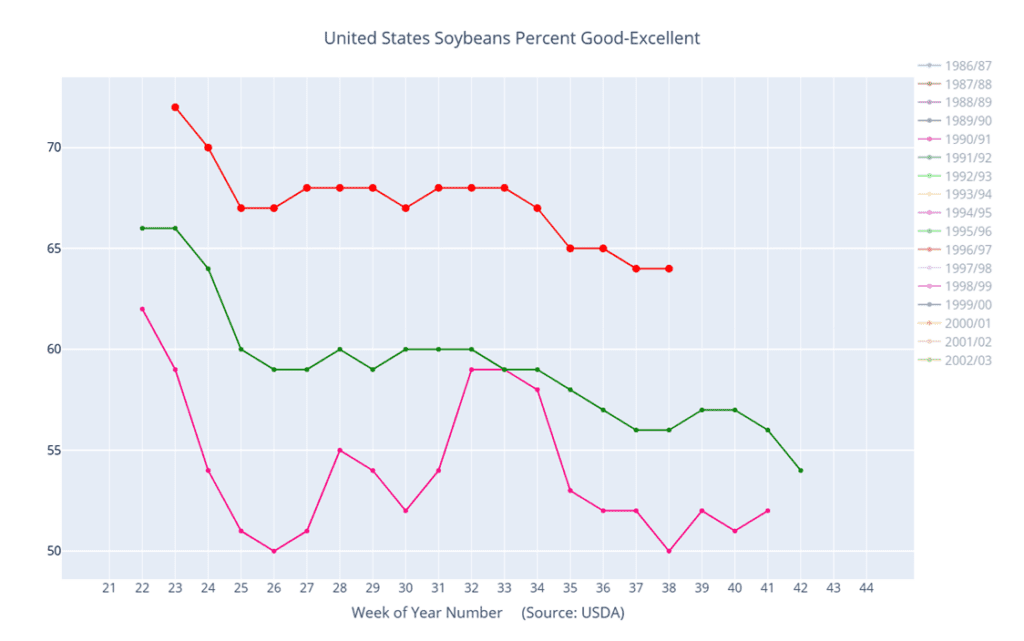
Above: Soybeans condition percent good-excellent (red) versus the 5-year average (green) and last year (pink).
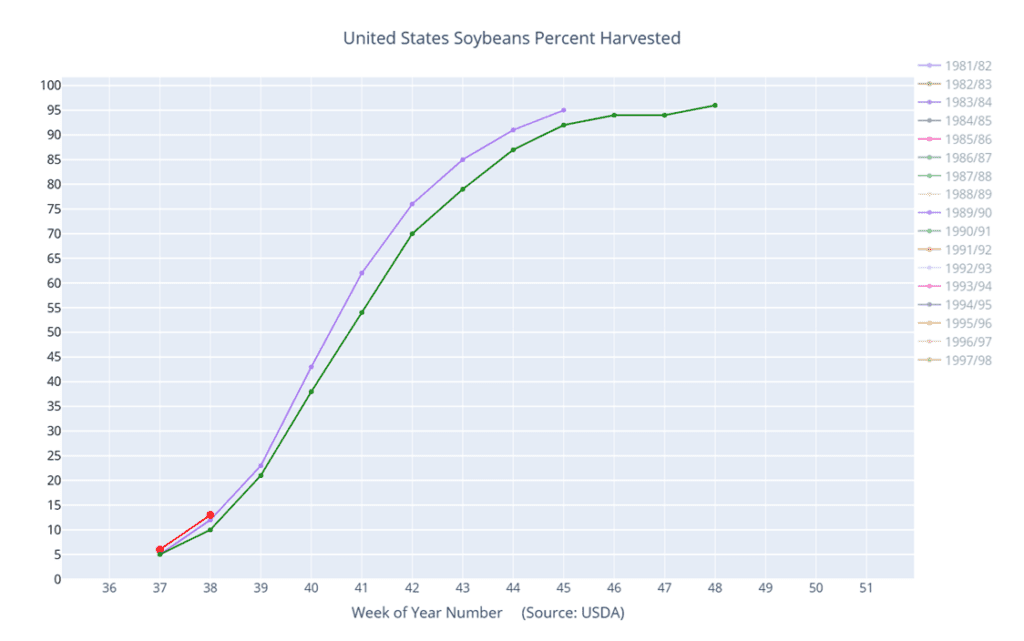
Above: Soybeans percent harvested (red) versus the 5-year average (green) and last year (purple).
Wheat
Market Notes: Wheat
- After a strong start to the session, all three US wheat classes ended with a negative close. Pressure came from lower trade in Paris milling wheat futures. Additionally, as soybean prices faded well off their daily highs, wheat prices followed suit. It’s also likely that some profit-taking by traders occurred after the recent rally from the August lows.
- According to the USDA’s Crop Progress report, 96% of US spring wheat has been harvested, just ahead of both last year’s pace and the 5-year average of 95%. In addition, 25% of the winter wheat crop has been planted, which is slightly ahead of last year’s 23% and the 24% average. Finally, 4% of winter wheat has emerged, compared to 6% a year ago and the 5% average.
- According to the Russian Agriculture Ministry, the 2024 grain harvest projection may be adjusted, as final estimates from different regions are expected by the end of the week. So far, Russia has collected 105.9 mmt of grain, with 77.7 mmt of that being wheat. Earlier in September, SovEcon forecasted Russian wheat production at 82.9 mmt.
- A port strike in Vancouver, Canada, began today and is expected to severely disrupt grain transport and logistics. Vancouver reportedly handled 52% of Canada’s grain shipments last year. An estimated 100,000 mt of daily crop deliveries will be halted, which comes right as farmers are getting into the thick of harvest.
Action Plan: Chicago Wheat
Calls
2024
No New Action
2025
No New Action
2026
No New Action
Cash
2024
No New Action
2025
No New Action
2026
No New Action
Puts
2024
No New Action
2025
No New Action
2026
No New Action
Chicago Wheat Action Plan Summary
Since mid-July, the wheat market has mostly drifted sideways as the trade tries to balance smaller US and global supplies against cheaper world export prices. During this period, a potential seasonal low was also marked on July 29th as managed funds maintained a sizable net short position in Chicago wheat. While slow global import demand and low Russian export prices continue to be a limiting factor in the market, any increase in US demand due to smaller crops in Europe and the Black Sea region could trigger an extended short-covering rally by managed funds.
- No new action is recommended for 2024 Chicago wheat. Considering the rally in wheat back in May, we recommended taking advantage of the elevated prices to make additional sales and buy upside July ’25 860 and 1020 calls (for their extended time frame) in case of a protracted rally. Our current strategy is to target 740 – 760 versus Dec ’24 to recommend further sales, while also targeting a selling price of about 73 cents in the 860 calls to achieve a net neutral cost on the remaining 1020 calls. The remaining 1020 calls would then continue to protect existing sales and give you confidence to make additional sales at higher prices.
- No new action is recommended for 2025 Chicago wheat. Recently, we recommended taking advantage of the wheat rally to sell more of your anticipated 2025 SRW production. While we continue to recommend holding the remaining July ’25 620 puts — after advising to exit the first half back in July — to maintain downside coverage for any unsold bushels, we are targeting a 10-15% extension from our last sale to the 650–680 area in July ’25 to suggest making additional sales.
- No action is currently recommended for 2026 Chicago Wheat. We currently aren’t considering any recommendations at this time for the 2026 crop that will be planted next year, and it may be some time before conditions are conducive to consider making any recommendations. Be patient as we monitor the markets for signs of improvement.
To date, Grain Market Insider has issued the following Chicago wheat recommendations:


Above: Since early September, prices have been mostly rangebound. Overhead, a close above 600 resistance could put prices on course to test the 640 – 645 area. Whereas a close below 560 could put the market at risk of trading down to the 50-day moving average with support near 544.
Action Plan: KC Wheat
Calls
2024
No New Action
2025
No New Action
2026
No New Action
Cash
2024
No New Action
2025
No New Action
2026
No New Action
Puts
2024
No New Action
2025
No New Action
2026
No New Action
KC Wheat Action Plan Summary
Since mid-July, the wheat market has mostly drifted sideways as the trade tries to balance smaller US and global wheat supplies against cheaper world export prices. During this period, a potential seasonal low was also marked on the front month continuous charts as managed funds maintained a sizable net short position in the wheat markets. While low Black Sea export prices and slow world demand continue to weigh on US prices, the funds’ short position could trigger an extended short covering rally on any increase in US demand as world wheat ending stocks are expected to fall yet again this year.
- No new action is recommended for 2024 KC wheat. Considering the upside breakout in KC wheat back in May, we recommended buying upside July ’25 860 and 1020 calls (for their extended time frame) in case of a protracted rally. Our current strategy is to target 675 – 700 versus Dec ’24 to recommend further sales, while also targeting a selling price of about 71 cents on the 860 calls to achieve a net neutral cost on the remaining 1020 calls. The remaining 1020 calls would then continue to protect existing sales and give you confidence to make additional sales at higher prices.
- No new action is currently recommended for 2025 KC Wheat. Earlier this summer we recommended exiting half of the previously recommended July ’25 620 puts once they reached 60 cents (double the original approximate cost) to realize gains in case the market rallies back, while still holding the remaining 620 puts at, or near, a net neutral cost for continued downside coverage on any unsold bushels. To that end, we are currently targeting the upper 400 range versus July ’25 to exit half of those remaining puts. Meanwhile, our current upside strategy is to target the 640 – 670 range, also in the July ’25, to recommend making additional sales.
- No action is currently recommended for 2026 KC Wheat. We currently aren’t considering any recommendations at this time for the 2026 crop that will be planted next year, and it may be some time before conditions are conducive to consider making any recommendations. Be patient as we monitor the markets for signs of improvement.
To date, Grain Market Insider has issued the following KC recommendations:


Above: December KC wheat appears to have found support right near the 50-day moving average and reversed back higher. Overhead, resistance remains near the 100 and 200-day moving averages near the recent 604 ¼ high. A close above there could put the market on track towards 637, whereas a close below 561 ¼ could put the market at risk of sliding towards the 527 ¼ low.

Above: Winter wheat percent planted (red) versus the 5-year average (green) and last year (purple).
Action Plan: Mpls Wheat
Calls
2024
No New Action
2025
No New Action
2026
No New Action
Cash
2024
No New Action
2025
No New Action
2026
No New Action
Puts
2024
No New Action
2025
No New Action
2026
No New Action
Mpls Wheat Action Plan Summary
Since printing a near-term low in mid-July, Minneapolis wheat has trended mostly sideways as the market attempts to balance smaller US and world supplies versus lower world export prices and lower world demand. During this period, managed funds have maintained their sizable, short positions in Minneapolis wheat. Though low Russian export prices continue to keep a lid on US prices, smaller crops in Europe and the Black Sea region could increase US demand, potentially triggering an extended short-covering rally, especially as global wheat ending stocks are projected to decline again this year.
- No new action is recommended for 2024 Minneapolis wheat. With the close below 712 support in June, Grain Market Insider implemented its Plan B stop strategy, recommending additional sales for the 2024 crop due to waning upside momentum and an increased likelihood of a downward trend. Given the heightened volatility and the amount of time that remains to market this crop, we will maintain the current July ’25 KC wheat 860 and 1020 call options. Our target is a selling price of about 71 cents for the 860 calls to achieve a net neutral cost on the remaining 1020 calls. These 1020 calls will continue to protect existing sales and provide confidence to make additional sales at higher prices. While we are at the time of year when market lows often occur, we will consider posting upside targets in late September or early October when market conditions often become more advantageous, and harvest is mostly behind us.
- No new action is currently recommended for the 2025 Minneapolis wheat crop. Since the growing season can often yield some of the best sales opportunities, we made two separate sales recommendations in July to get some early sales on the books for next year’s crop. While we will not be targeting any specific areas to make additional sales until later in the marketing year, we will continue to monitor the market for opportunities to exit the remaining July ’25 KC 620 puts that were recommended in June. To that end, we are currently targeting the upper 400 range versus July ’25 KC to exit half of those remaining puts.
- No Action is currently recommended for the 2026 Minneapolis wheat crop. We currently aren’t considering any recommendations at this time for the 2026 crop that will be planted 2 years from now, and it may be some time before conditions are conducive to consider making any recommendations. Be patient as we monitor the markets for signs of improvement.
To date, Grain Market Insider has issued the following Minneapolis wheat recommendations:


Above: Since early September, December Minneapolis wheat has been largely rangebound between support near the 50-day moving average and resistance near 637. A breakout to the upside could put the market in position to rally toward 685, with potential resistance around the 100 and 200-day moving averages. To the downside, a break below the 50-day moving average could put the market at risk of sliding towards 560.
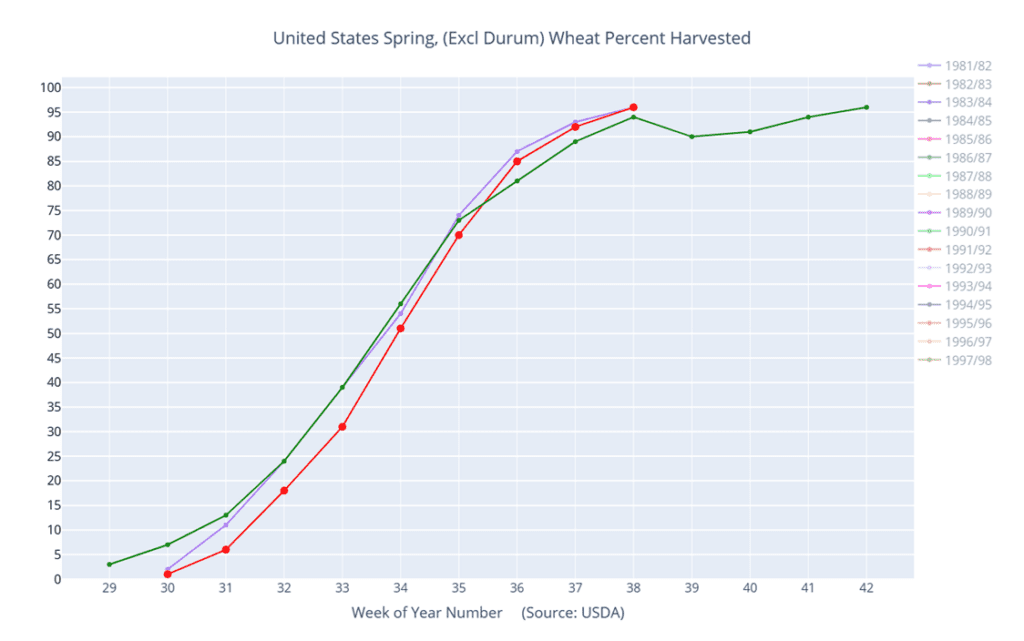
Above: Spring wheat percent harvested (red) versus the 5-year average (green) and last year (purple).
Other Charts / Weather

Above: US 5-day precipitation forecast courtesy of NOAA, Weather Prediction Center.
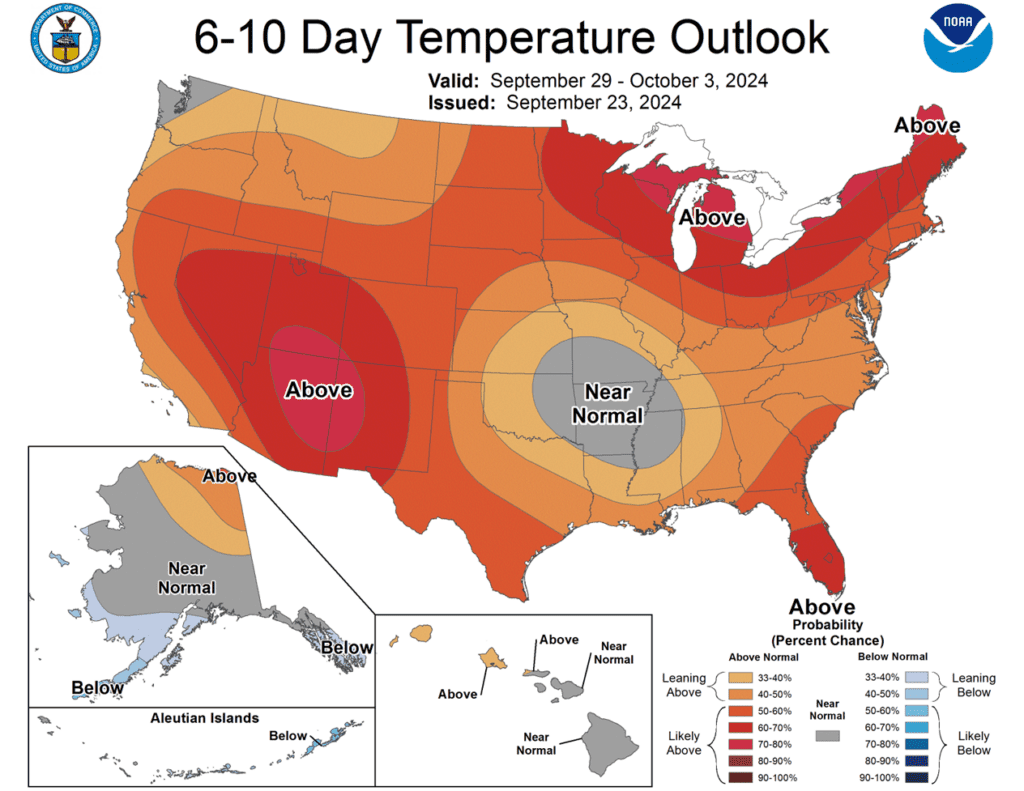
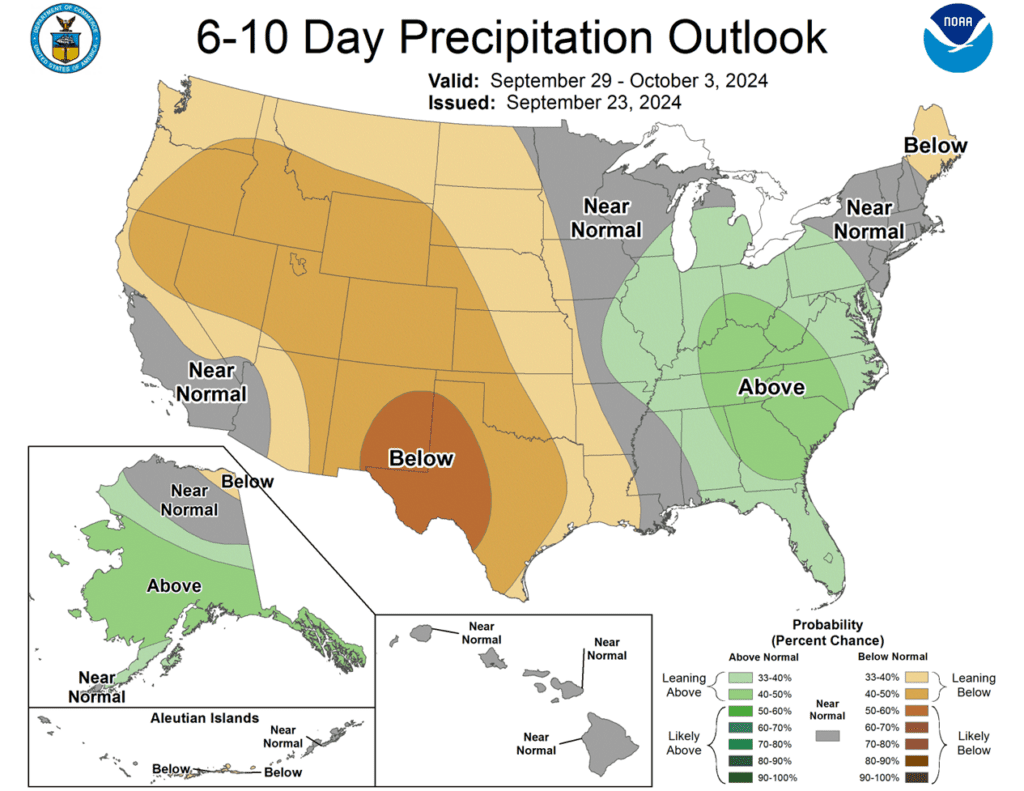

Above: Brazil 2-week forecast precipitation, percent of normal, courtesy of the National Weather Service, Climate Prediction Center.
